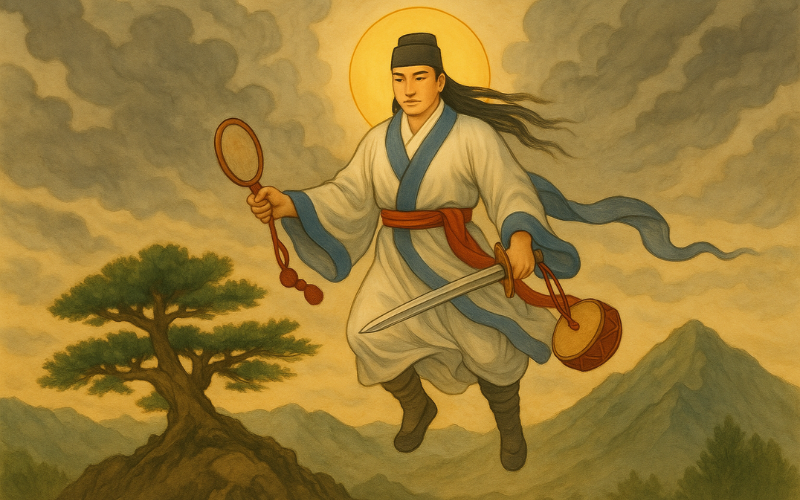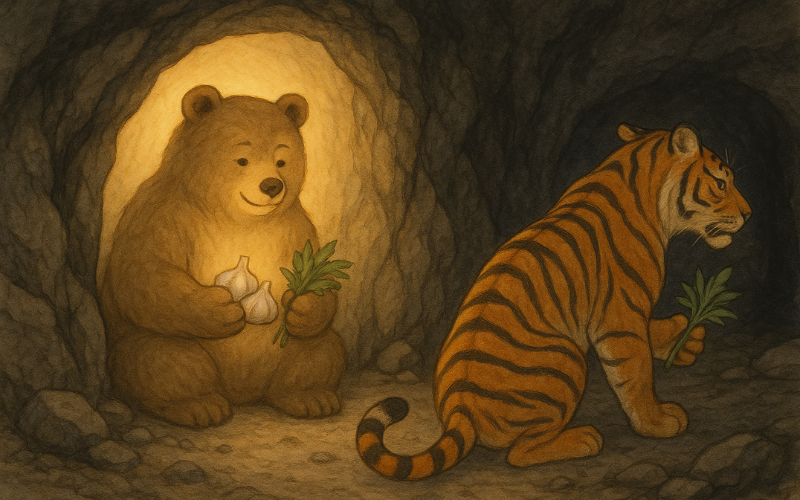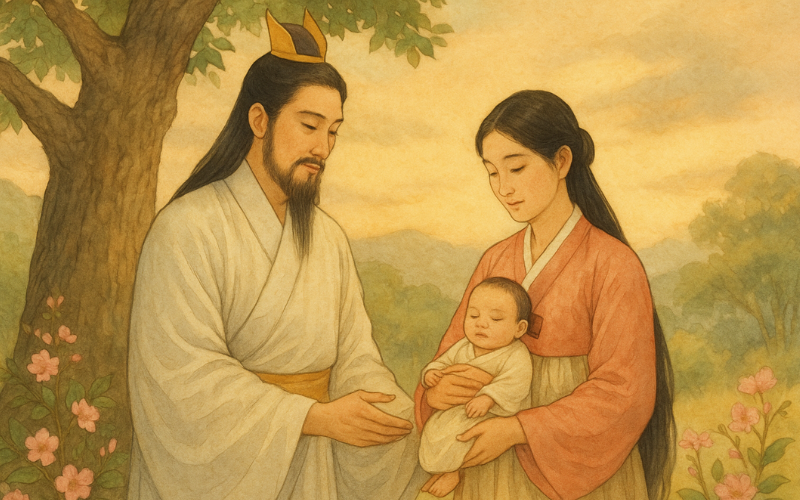The Myth of Dangun Wanggeom
Hwanung, the son of the celestial deity Hwanin, expressed a profound desire to descend to Earth and govern humanity benevolently. Seeing his son’s noble intentions, Hwanin permitted him and gave him three divine treasures (Cheonbuin), which symbolise the shaman king’s authority and power: These included a mirror (Singyeong, 신경), a sword (Singeom, 신검), and ritual instruments such as a rattle (Sillyeong, 신령) or a drum (Singo, 신고), meant to summon the gods and communicate human affairs. These powers symbolise the divine power and connection to heaven.

A divine and serene scene of Hwanung’s descent from the heavens. Soft clouds surround the Holy Tree (Shindansu), and the sacred treasures—mirror, sword, and drum—radiate subtle spiritual energy. [Picture Credit - Sumaiya Chauhan]
Hwanung, along with his followers, approximately 3000, including spirits of rain, wind and clouds, descended at the Shindansu (the Holy Tree) at Mount Taebaek ( modern-day Baekdu Mountain). There, he established a divine city called Sinsi, the “City of God.” Hwanung presided over to teach humans.

Inside the dark cave, the tiger appears restless, garlic and mugwort clutched in its paws. The bear glows faintly with patience, embodying determination and quiet transformation. [Picture Credit - Sumaiya Chauhan]
The Tiger, the Bear, and the Birth of Dangun
In a cave at Mount Taebaek, a tiger and a bear prayed to Hwanung, asking him to transform them into humans. Moved by their earnest plea, Hwanung bestowed upon them sacred mugwort (Ssuk, 쑥) and twenty cloves of garlic (Maneul, 마늘), bidding them to endure a hundred days in the darkness of a cave to earn their human form. If they could be able to complete this challenge, then they would be transformed into humans.
The tiger, unable to withstand the trial, gave up and left the cave after 21 days. Yet the bear, steadfast and resolute, remained in the darkness, enduring the test with unwavering patience. After completing the test, the bear was transformed into a beautiful woman named Ungnyeo (웅녀). Her transformation is a powerful metaphor for perseverance and feminine resilience in Korean storytelling. Although Ungnyeo had become human, she was lonely and prayed to Sindansu (Divine Altar Tree) for a child. Hwanung, hearing Ungnyeo’s earnest prayer, joined with her in sacred union, and thus Dangun Wanggeom came into the world.

The emotional climax of the myth is the fulfilment of the myth’s emotional arc—Ungnyeo’s transformation into a human, her loneliness turned into the divine fulfilment of her patience and prayer, as now Hwanin took her as her wife. And through their union, the Divine being “Dangun” was born. [Picture Credit - Sumaiya Chauhan]
The Foundation of Gojoseon, 2333 BCE
At the beginning of 2333 BCE, Dangun Wanggeom established the sacred foundations of Korea's first kingdom, Gojoseon, and ruled as its esteemed ruler, according to the 'Gii'—the Records of Marvels—in Samguk Yusa. When his time among mortals came to an end, he turned away from earthly rule. Some say he ascended to the heavens, becoming the mountain spirit of Asadal—enshrined in myth, and honoured in ritual by generations who whispered his name with reverence.
Every year on October 3rd, Gaecheonjeol (개천절), or National Foundation Day, is celebrated in Korea to honour this myth. It’s more than just a founding tale—it’s a spiritual and cultural root that Koreans still feel today. When I first heard this story, I always sensed how it reflects not just a divine narrative, but values still alive in Korean society: reverence for nature, respect for ancestors, and the importance of patience and virtue.
The ideology of Hongik Ingan (홍익인간)—“benefiting all humankind”—has shaped Korea’s approach to education, governance, and global citizenship. From school mottos to national policy, it echoes the foundational ideals established by Dangun.
Reflection: Why These Myths Still Matter
To me, what makes this myth special isn’t just its grandeur—it’s the deeply personal emotions embedded in it. Ungnyeo’s loneliness and perseverance, and Dangun’s divine mission aren’t just symbolic—they’re human. They mirror struggles we still face: waiting in the dark, hoping for light.
In a fast-moving, modern Korea, these ancient stories serve as grounding forces. They remind us of our roots, connect us to nature and the cosmos, and define what it means to be Korean—not by blood alone, but by shared belief, endurance, and purpose.
Apart from contributing to serving as amusement, folktales and myths such as the legend of Dangun Wanggeom are vital to Korean cultural identity because they uphold the country's fundamental ideals, religious convictions, and shared experiences. These tales provide profound insight into the history and present cultural consciousness of Korea by addressing themes of justice, loyalty, and the paranormal. Their lasting impact is evident in literature, art, national rites, and movies like Along with the Gods, which serve as a constant reminder to Koreans of their identity, origins, and the everlasting power of stories that have been passed down through the ages.
How about this article?
- Like0
- Support0
- Amazing0
- Sad0
- Curious0
- Insightful2


